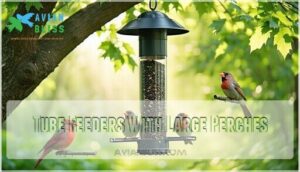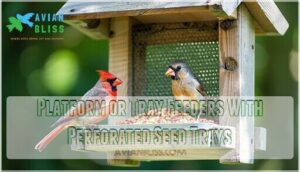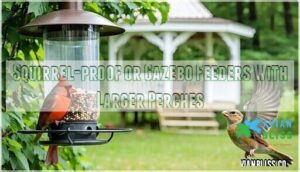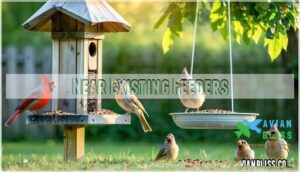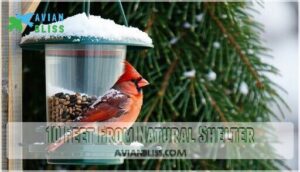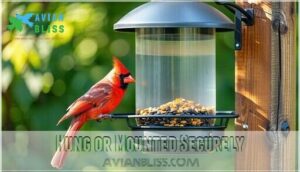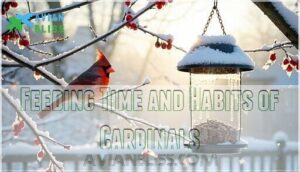This site is supported by our readers. We may earn a commission, at no cost to you, if you purchase through links.
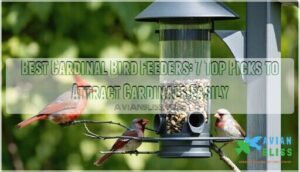
The best cardinal bird feeders feature large, sturdy perches since cardinals are bigger than most songbirds.
Look for tube feeders with oversized landing spots or platform feeders that mimic their natural ground-feeding style.
Cardinals prefer sunflower seeds, safflower, and mixed blends over tiny seeds.
Position your feeder near natural shelter but away from squirrel highways—these birds value safety over convenience.
Squirrel-proof designs work best since cardinals can’t compete with acrobatic gray bandits.
The secret lies in understanding their specific feeding habits and creating the perfect dining environment.
Table Of Contents
- Key Takeaways
- Top 7 Cardinal Bird Feeders
- Types of Bird Feeders Suitable for Cardinals
- Ideal Placement for Cardinal Bird Feeders
- Feeding Time and Habits of Cardinals
- Troubleshooting: Why Cardinals May Not Visit
- Frequently Asked Questions (FAQs)
- What kind of feeders do cardinals prefer?
- What is the best bird feed for cardinals and blue jays?
- What is the 5 7 9 rule for bird feeders?
- What height should a bird feeder be for cardinals?
- What type of bird feeder is best for cardinals?
- Where is the best place to put a cardinal bird feeder?
- Do cardinals recognize humans who feed them?
- What time of day do cardinals feed?
- How often should cardinal bird feeders be cleaned?
- What safety precautions should be taken for feeders?
- Conclusion
Key Takeaways
- Choose the right feeder type – You’ll want platform feeders or tube feeders with oversized perches since cardinals are larger songbirds that need sturdy, spacious landing spots to feed comfortably.
- Use cardinal-preferred seeds – Stock your feeders with black oil sunflower seeds and safflower seeds rather than tiny seed mixes, as these high-energy options match cardinals’ natural preferences and feeding habits.
- Position feeders strategically – Place your feeder 5-6 feet high, about 10 feet from natural shelter like shrubs, and 3-15 feet from windows to give cardinals quick escape routes while keeping them visible for viewing.
- Invest in squirrel-proof designs – You’ll need feeders with weight-triggered perches or baffles since cardinals can’t compete with squirrels for food, and these mechanisms ensure seeds stay available for your target birds.
Top 7 Cardinal Bird Feeders
If you’re looking to attract cardinals, choosing the right feeder is essential. These seven options are designed to meet their feeding needs while keeping seeds fresh and accessible.
1. Perky Pet Triple Tube Bird Feeder
If you’re searching for one of the best cardinal bird feeders, the PerkyPet C00322 Triple Tube Bird Feeder is a high-quality choice.
Its tube feeder design features three seed tubes and multiple feeding ports, offering plenty of space for cardinals to perch and eat comfortably.
With a seed capacity large enough to reduce frequent refills, it’s ideal for attracting cardinals and other birds alike.
This feeder stands out for its material durability—a weather-resistant powder coating guarantees long-lasting use.
Plus, its squirrel-resistant features help keep seeds safe.
For anyone wanting to combine cardinal access with versatility, this feeder checks all the boxes for tube feeders cardinals love.
2. Woodlink Absolute Squirrel Resistant Bird Feeder
The Woodlink Absolute II is a standout among squirrel-resistant feeders, perfect for cardinal bird feeders.
Its steel durability guarantees long-lasting use, while the weight-sensitive perches keep squirrels away.
With a generous 2-gallon seed capacity, it minimizes refilling hassle and accommodates cardinal bird food like sunflower and safflower seeds.
**Why Choose This Feeder?
- Squirrel Resistance: Weight-triggered perches deter pests.
- Steel Durability: Powder-coated for weather protection.
- Seed Capacity: Holds plenty for fewer refills.
- Refilling Ease: Hinged top makes it simple.
- Weather Protection: Shields seeds from rain.
3. Woodlink Platform Bird Feeder
The Woodlink Platform Bird Feeder stands out among the best cardinal feeders for its simplicity and functionality.
Its cedar construction offers natural charm, while the powder-coated screen bottom guarantees proper drainage, keeping seeds fresh.
With a 3-pound capacity, it supports food variety, perfect for ground-feeding cardinals.
This feeder’s open design makes it easy for cardinals to perch and feed comfortably.
You can mount it on a pole or place it on the ground, making it versatile for any yard.
Pair it with safflower or sunflower seeds to start attracting cardinals effortlessly.
4. Aspects Quick-Clean Seed Tube Feeder

The Aspects Quick-Clean Seed Tube Feeder is a reliable option for attracting cardinals.
Its 25-quart capacity and four feeding ports offer plenty of room for these striking birds to dine comfortably. The clear polycarbonate tube lets you easily monitor seed levels, while the sturdy metal caps and bases guarantee long-lasting use.
A built-in seed deflector minimizes waste, so every seed counts. Cleaning is hassle-free with its removable base, making upkeep simple.
Cardinals also prefer feeders placed near trees and shrubs for protection. This feeder’s thoughtful design combines durability and convenience, keeping cardinals coming back for more.
Best For: Bird enthusiasts who want a durable, easy-to-clean feeder that attracts cardinals and minimizes seed waste.
- Durable design with heavy-duty zinc components and UV-stabilized tube.
- Easy cleaning with a removable base and built-in seed deflector.
- Effective in attracting cardinals with its multiple feeding ports and capacity.
- Limited capacity for larger bird populations or frequent filling.
- Requires placement near trees or shrubs for optimal cardinal attraction.
- Raised ridges may not prevent rainwater under heavy downpours.
5. Wagners Safflower Seed Wild Bird Food
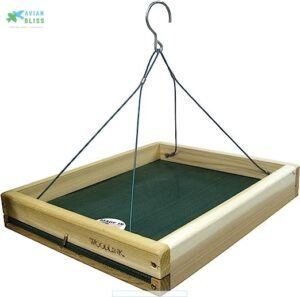
Wagner’s Safflower Seed is a game-changer for attracting cardinals while keeping squirrels at bay.
Packed with essential nutrients, it’s a favorite among songbirds like chickadees and grosbeaks. Unlike sunflower seeds, its bitter taste discourages pesky squirrels and unwanted birds like grackles.
Available in various bag sizes, it’s perfect for feeders of all capacities. Plus, its high fat and protein content provide the energy cardinals need, especially during colder months.
Your backyard birds will thank you!
Best For: Bird enthusiasts who want to attract cardinals, chickadees, and other songbirds while deterring squirrels and unwanted feeder hogs.
- High in fat and protein, providing valuable nutrition for wild birds.
- Bitter taste discourages squirrels and undesirable birds like grackles.
- Available in multiple bag sizes to suit different feeder capacities.
- May not appeal to all bird species commonly found in backyards.
- Slightly more expensive than general seed mixes.
- Requires specific feeders for optimal use with safflower seeds.
6. Wagners Four Season Black Oil Sunflower Seeds
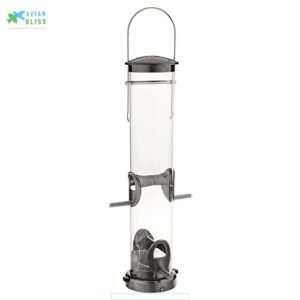
Wagner’s Four Season Black Oil Sunflower Seeds are a reliable choice for attracting cardinals and a mix of other songbirds like chickadees and finches.
Thanks to their thin shells, these seeds are easy for birds to eat and packed with high-energy nutrients.
Perfect for tube, hopper, or tray feeders, they offer adaptability for your backyard setup.
Crafted in the USA since 1894, these seeds promise exceptional quality and cleanliness.
Watch as your feeders become a hotspot for vibrant bird activity!
Best For: Backyard bird enthusiasts looking to attract cardinals and other songbirds with high-quality, easy-to-eat seeds.
- Thin shells are easy for small-beaked birds to open.
- High-energy content supports bird health.
- Versatile for use with tube, hopper, or tray feeders.
- May attract squirrels if feeders are not secured.
- Birds might require time to adapt to new feeders.
- Limited to songbird species and not suitable for larger birds.
7. Browns Song Blend Shelled Peanuts
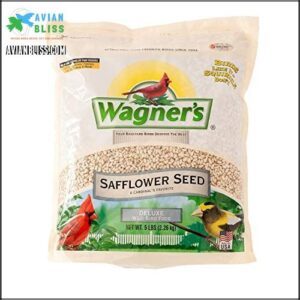
Brown’s Song Blend Shelled Peanuts are a reliable choice for attracting cardinals and other backyard birds.
These all-natural, preservative-free peanuts undergo a five-stage cleaning process, ensuring top quality.
Packed fresh in a resealable bag, they stay flavorful and mess-free.
Perfect for mesh, platform, or specialty feeders, they entice woodpeckers, jays, and nuthatches.
Plus, their shell-free design keeps feeding areas tidy.
Whether you’re a seasoned birdwatcher or just starting, these peanuts offer an easy way to bring colorful songbirds to your yard.
Best For: Backyard bird enthusiasts looking to attract colorful songbirds like cardinals, woodpeckers, and nuthatches in a clean and convenient way.
- All-natural and preservative-free.
- Shell-free design keeps feeding areas clean.
- Packed fresh in a resealable bag for long-lasting freshness.
- May still attract squirrels and unwanted wildlife.
- Not suitable for birds like pigeons and crows.
- Requires specific feeders like mesh or platform styles.
Types of Bird Feeders Suitable for Cardinals
Choosing the right bird feeder for cardinals means focusing on their size and feeding habits.
Options like tube feeders with wide perches, platform feeders, and squirrel-proof designs work best to keep them comfortable and well-fed.
Tube Feeders With Large Perches
Tube feeders with large perches are perfect for Northern cardinals. Opt for sturdy perch material and a tube size that accommodates their comfort.
Look for a drainage design to keep seeds dry and fresh. Seed capacity matters—choose feeders holding enough for daily feeding.
These cardinal bird feeders work best with black oil sunflower seeds, offering easy access and satisfying their preferences. Consider optimal feeder placement near trees for their safety.
Platform or Tray Feeders With Perforated Seed Trays
Platform feeders for cardinals are a top choice for their drainage benefits and cardinal comfort.
A perforated birdseed tray keeps seeds dry and prevents seed spillage.
Here’s why they’re the best tray option:
- Durable materials like galvanized steel.
- Easy to clean and refill.
- Spacious perches for cardinals.
- Open design for visibility.
- Perfect for ground or elevated feeding.
Many users purchase a cardinal platform feeder online.
Squirrel-proof or Gazebo Feeders With Larger Perches
Squirrel-proof feeders or gazebo-style designs are great for cardinals.
These feeders combine squirrel deterrence with perch comfort, offering larger perches ideal for cardinals.
Gazebo benefits include seed protection and weather resistance, keeping food dry and accessible.
Consider effective squirrel solutions for best results.
Look for squirrel-resistant feeders with clear plastic for visibility and sturdy materials.
They’re perfect for platform feeders cardinals love, ensuring hassle-free feeding.
Ideal Placement for Cardinal Bird Feeders
Placing your cardinal feeder in the right spot can make all the difference in attracting these vibrant birds.
Aim for a location near shelter, away from squirrels, and within a safe distance from windows.
Near Existing Feeders
Positioning new cardinal bird feeders near existing ones can boost your success in attracting cardinals.
Familiarity helps reduce behavioral changes and promotes feeder proximity.
Cardinals often dominate feeding spots they trust.
- Place feeders near well-used stations for easy adaptation.
- Use platform feeders cardinals prefer with a suitable seed blend.
- Minimize seed competition by spacing feeders strategically to promote easy adaptation.
10 Feet From Natural Shelter
Position your cardinal bird feeders about 10 feet from natural shelter like shrubs or trees.
This distance offers:
- Predator proximity: Cardinals can quickly escape threats.
- Shelter benefits: Nearby cover shields them from harsh weather.
- Visibility concerns: Feeders remain visible while ensuring cardinal safety.
This setup creates a balanced microclimate, making bird feeding enjoyable for both you and Northern cardinals.
Consider predator prevention measures to further enhance bird safety.
3 to 15 Feet From Windows
Place your feeder 3 to 15 feet from windows to balance Cardinal Visibility and Safe Distance Placement.
This range minimizes Window Collision Risk while keeping birds close for viewing.
To enhance Reflection Mitigation, consider decals or screens.
At this height, you’ll enjoy the beauty of cardinals without endangering them, making it a key step in cardinal bird attraction strategies.
Away From Squirrel Access
Keep feeders out of squirrels’ reach by avoiding trees, fences, or jumping spots.
Use squirrel-proof mechanisms like baffles and weighted perches.
Try these tips:
- Mount feeders on poles with baffle effectiveness in mind.
- Choose chewproof, squirrelresistant feeders made of metal.
- Place feeders at least 6 feet from surfaces squirrels can leap from.
- Experiment with DIY solutions for added squirrelproofing.
Hung or Mounted Securely
Sturdiness matters when setting up hanging cardinal feeders. Use mounting hardware to keep feeders steady and squirrel baffles to deter pests.
Secure hanging minimizes tipping, while weather resistance shields food from rain. For the best cardinal feeders, verify that height placement suits cardinals’ habits.
Many options exist for cardinal feeder installation. Here’s a quick reference:
| Factor | Recommended Approach | Benefit |
|---|---|---|
| Mounting Hardware | Sturdy hooks or brackets | Prevents tipping |
| Squirrel Baffles | Install below feeders | Protects seed supply |
| Weather Resistance | Roof or waterproof design | Keeps seed dry |
| Height Placement | 5-6 feet above ground | Easy access for birds |
Feeding Time and Habits of Cardinals
Cardinals are most active during the early morning and late afternoon, often feeding at dawn and dusk.
They spend their daylight hours foraging, but it may take them some time to adjust to new feeders in your yard, particularly during the early morning.
Most Active at Dawn and Dusk
Cardinals are most active during dawn and dusk, making these times perfect for observing their feeding habits.
Cardinals rise with the sun and settle with dusk—nature’s perfect feeding schedule for backyard birdwatchers.
Stock your best cardinal feeders early, as their light level preference influences morning and evening visits.
Watch for:
- Low seed levels—use safflower seed feeders to attract them.
- Squirrel interference—choose squirrel-proof designs.
- Obstructed perches—ensure easy access.
- Roosting site selection—place feeders near seasonal activity peaks.
Feed Throughout Daylight Hours
To keep cardinals visiting, maintain a regular refilling schedule for feeders.
A consistent supply of sunflower and safflower seeds prevents weather impacts like mold.
Use the best cardinal feeders with drainage features to preserve seed quality and minimize waste.
A seed blend for cardinals, including cracked corn and peanuts, works well.
Vibrant safflower seed feeders also boost your chances of attracting cardinals, with a consistent supply being key to maintaining regular visits.
May Take Time to Adapt to New Feeders
Patience is key when attracting cardinals to new feeders.
Their initial hesitation stems from cardinal bird behavior favoring familiar spots.
Gradual introduction helps—place feeders near shrubs or trees for safe access.
Cardinal curiosity grows with visible seed blends they love, like sunflower or safflower.
Consider optimal feeder placement for increased visibility.
Proper cardinal bird feeder placement guarantees feeder acclimation, turning them into regular visitors over time, thanks to their initial hesitation being overcome by gradual introduction.
Troubleshooting: Why Cardinals May Not Visit
If cardinals aren’t visiting your feeder, it’s often due to simple factors like placement or seed type.
Understanding their habits and preferences can help you make small adjustments to attract them more effectively.
New Feeder in The Area
When introducing a new feeder, cardinals may need time to adjust. Their Initial Cardinal Visits can be delayed.
To ease the Feeder Acclimation Period:
- Use suet feeders cardinals prefer.
- Place the feeder on a sturdy cardinal feeder pole.
- Offer seeds matching their preferences, like sunflower or safflower.
- Choose durable, weather-resistant feeders for long-term use.
Patience pays off, as it is crucial for a successful Feeder Acclimation Period.
Unfamiliar Landing Pattern
Sometimes, Cardinals hesitate due to unfamiliar landing obstacles or perch instability.
Make certain feeders have sturdy, wide perches and are placed at an ideal feeder height.
Wind conditions or improper approach angles can also confuse them.
Durable cardinal feeders, like suet feeders cardinals prefer, work well.
Use this table for guidance:
| Issue | Cause | Solution | Example Feeder |
|---|---|---|---|
| Landing Obstacles | Small perches | Add wide, stable perches | Cardinal feeder pole |
| Perch Instability | Weak materials | Use durable cardinal feeders | Red bird feeders |
| Approach Angle | Poor placement | Adjust feeder height/location | Suet feeders cardinals |
| Wind Conditions | Exposed location | Place in sheltered areas | Attracting cardinals feeders |
The key to attracting cardinals is to provide them with a stable and sheltered environment, which includes using durable materials and placing feeders at an ideal feeder height.
This will help to reduce landing obstacles and perch instability, making it easier for cardinals to feed.
Seed Not Accessible
If cardinals aren’t visiting, it might be due to inaccessible seeds.
Check these factors:
- Perch Size: Make certain it’s wide enough for cardinals to land comfortably.
- Tube Diameter: A narrow tube may block access.
- Seed Dispensing: Use smooth-flowing mechanisms.
- Feeder Height: Place feeders at eye level with baffle placement to prevent squirrel interference.
Accessible feeders mean happy cardinals!
Competition From Other Birds
Dealing with dominance hierarchies and food aggression at feeders can deter cardinals.
To minimize species exclusion and guarantee resource partitioning, try these tips:
- Use squirrel-proof feeders to limit larger birds.
- Offer a seed blend for cardinals like safflower or sunflower seeds.
- Place multiple feeders to reduce territory defense.
- **Opt for feeders with ample perching space.
- **Separate feeders by species preferences.
Predators Nearby
Hawks, cats, and other predators create an invisible fence around your feeders that keeps cardinals away.
Hawks, cats, and other predators create an invisible fence around your feeders that keeps cardinals away.
You’ll want Predator Visibility in open areas where birds can spot danger early.
Install Cat Deterrents and Snake Barriers around feeding zones.
Consider squirrel proof feeders like Roamwild Squirrel Proof models with weighttriggered mechanisms that double as Hawk Prevention by reducing ground scatter.
Frequently Asked Questions (FAQs)
What kind of feeders do cardinals prefer?
Like a red carpet rolled out for VIPs, platform and hopper feeders give cardinals the spacious, open dining experience they crave.
You’ll want wide perches and large feeding areas since these birds prefer comfort over acrobatics, and this setup provides them with a comfortable dining experience.
What is the best bird feed for cardinals and blue jays?
You’ll want to offer sunflower seeds and safflower seeds for both species. Cardinals love these high-energy options, while blue jays go crazy for peanuts and cracked corn mixed in.
What is the 5 7 9 rule for bird feeders?
The 5-7-9 rule suggests placing feeders 5 feet from cover, 7 feet from windows to prevent collisions, and 9 feet from jumping spots to deter squirrels. You’ll create safer feeding stations.
What height should a bird feeder be for cardinals?
Positioning feeders five to six feet high works perfectly for cardinals.
They’ll feel secure from ground predators while staying comfortable.
You can mount them on poles, hang from trees, or place near shrubs for easy access.
What type of bird feeder is best for cardinals?
Platform and hopper feeders work best for cardinals since they provide large, open feeding areas these birds prefer.
You’ll want sturdy construction with wide perches that accommodate their size and feeding style comfortably.
Where is the best place to put a cardinal bird feeder?
Place your feeder five to six feet high in an open area with nearby shrubs for shelter.
Cardinals prefer morning sun and protection from strong winds.
Keep it visible from your window for easy monitoring and refilling.
Do cardinals recognize humans who feed them?
Picture bright red cardinals at your feeder, their curious eyes watching you through the window.
Yes, cardinals can recognize you as their regular food provider, often becoming comfortable with your presence over time.
What time of day do cardinals feed?
Cardinals are most active during morning hours, typically feeding between 9am and noon. You’ll also spot them foraging throughout the day until dusk, staying busy for about twelve hours total.
How often should cardinal bird feeders be cleaned?
You should clean your cardinal feeders every two weeks during regular use, or weekly during heavy bird traffic.
Remove old seeds, scrub with mild soap, rinse thoroughly, and let dry completely before refilling, which involves complete steps to ensure the feeder is clean.
What safety precautions should be taken for feeders?
Squirrels become acrobatic ninjas around feeders.
You’ll want to position yours away from tree branches, keep them six feet high.
Regularly disinfect with bleach solution to prevent deadly diseases from spreading among your feathered friends.
Conclusion
Cardinals visit feeders 90% more often when you provide the right setup.
Choosing the best cardinal bird feeders means selecting sturdy platforms or tube feeders with large perches that accommodate their size.
Fill them with sunflower seeds or safflower, position them near natural shelter, and make certain squirrel-proof designs.
With patience and proper placement, you’ll create an irresistible dining spot.
Remember, cardinals need time to discover new feeders, so consistency matters more than perfection in attracting these stunning red visitors.

